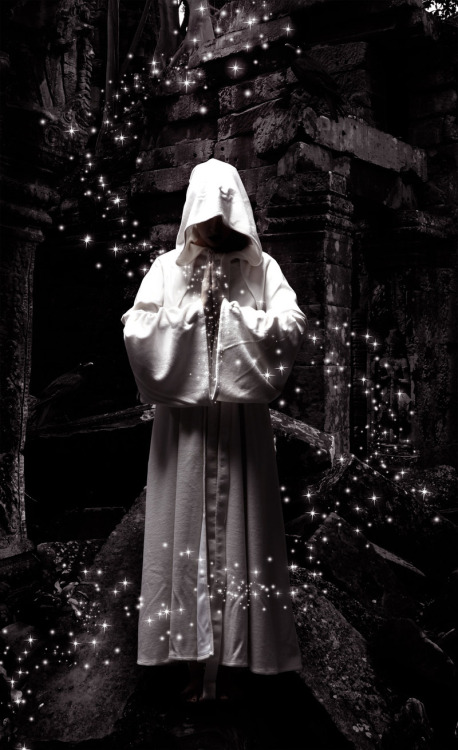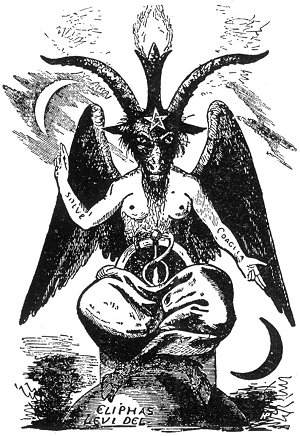Ceremonial Magic and Sorcery | Chapter 21
CEREMONIAL magic is the ancient art of invoking and controlling spirits by a scientific application of certain formulæ. A magician,  enveloped in sanctified vestments and carrying a wand inscribed with hieroglyphic figures, could by the power vested in certain words and symbols control the invisible inhabitants of the elements and of the astral world. While the elaborate ceremonial magic of antiquity was not necessarily evil, there arose from its perversion several false schools of sorcery, or black magic.
enveloped in sanctified vestments and carrying a wand inscribed with hieroglyphic figures, could by the power vested in certain words and symbols control the invisible inhabitants of the elements and of the astral world. While the elaborate ceremonial magic of antiquity was not necessarily evil, there arose from its perversion several false schools of sorcery, or black magic.
Egypt, a great center of learning and the birthplace of many arts and sciences, furnished an ideal environment for transcendental experimentation. Here the black magicians of Atlantis continued to exercise their superhuman powers until they had completely undermined and corrupted the morals of the primitive Mysteries. By establishing a sacerdotal caste they usurped the position formerly occupied by the initiates, and seized the reins of spiritual government.
Thus black magic dictated the state religion and paralyzed the intellectual and spiritual activities of the individual by demanding his complete and unhesitating acquiescence in the dogma formulated by the priestcraft. The Pharaoh became a puppet in the hands of the Scarlet Council–a committee of arch-sorcerers elevated to power by the priesthood.
These sorcerers then began the systematic destruction of all keys to the ancient wisdom, so that none might have access to the knowledge necessary to reach adeptship without first becoming one of their order. They mutilated the rituals of the Mysteries while professing to preserve them, so that even though the neophyte passed through the degrees he could not secure the knowledge to which he was entitled. Idolatry was introduced by encouraging the worship of the images which in the beginning the wise had erected solely as symbols for study and meditation. False interpretations were given to the emblems and figures of the Mysteries, and elaborate theologies were created to confuse the minds of their devotees. The masses, deprived of their birthright of understanding and groveling in ignorance, eventually became the abject slaves of the spiritual impostors. Superstition universally prevailed and the black magicians completely dominated national affairs, with the result that humanity still suffers from the sophistries of the priestcrafts of Atlantis and Egypt.
Fully convinced that their Scriptures sanctioned it, numerous mediæval Qabbalists devoted their lives to the practice of ceremonial magic. The transcendentalism of the Qabbalists is founded upon the ancient and magical formula of King Solomon, who has long been considered by the Jews as the prince of ceremonial magicians.
Among the Qabbalists of the Middle Ages were a great number of black magicians who strayed from the noble concepts of the Sepher Yetzirah and became enmeshed in demonism and witchcraft. They sought to substitute magic mirrors, consecrated daggers, and circles spread around posts of coffin nails, for the living of that virtuous life which, without the assistance of complicated rituals or submundane creatures, unfailingly brings man to the state of true individual completion.
Those who sought to control elemental spirits through ceremonial magic did so largely with the hope of securing from the invisible worlds either rare knowledge or supernatural power. The little red demon of Napoleon Bonaparte and the infamous oracular heads of de Medici are examples of the disastrous results of permitting elemental beings to dictate the course of human procedure. While the learned and godlike dæmon of Socrates seems to have been an exception, this really proves that the intellectual and moral status of the magician has much to do with the type of elemental he is capable of invoking. But even the dæmon of Socrates deserted the philosopher when the sentence of death was passed.
Transcendentalism and all forms of phenomenalistic magic are but blind alleys–outgrowths of Atlantean sorcery; and those who forsake the straight path of philosophy to wander therein almost invariably fall victims to their imprudence. Man, incapable of controlling his own appetites, is not equal to the task of governing the fiery and tempestuous elemental spirits.
Many a magician has lost his life as the result of opening a way whereby submundane creatures could become active participants in his affairs. When Eliphas Levi invoked the spirit of Apollonius of Tyana, what did he hope to accomplish? Is the gratification of curiosity a motive sufficient to warrant the devotion of an entire lifetime to a dangerous and unprofitable pursuit? If the living Apollonius refused to divulge his secrets to the profane, is there any probability that after death he would disclose them to the curious-minded?
Levi himself did not dare to assert that the specter which appeared to him was actually the great philosopher, for Levi realized only too well the proclivity of elementals to impersonate those who have passed on. The majority of modern mediumistic apparitions are but elemental creatures masquerading through bodies composed of thought substance supplied by the very persons desiring to behold these wraiths of decarnate beings.
THE THEORY AND PRACTICE OF BLACK MAGIC
Some understanding of the intricate theory and practice of ceremonial magic may be derived from a brief consideration of its underlying premises.
First. The visible universe has an invisible counterpart, the higher planes of which are peopled by good and beautiful spirits; the lower planes, dark and foreboding, are the habitation of evil spirits and demons under the leadership of the Fallen Angel and his ten Princes.
Second. By means of the secret processes of ceremonial magic it is possible to contact these invisible creatures and gain their help in some human undertaking. Good spirits willingly lend their assistance to any worthy enterprise, but the evil spirits serve only those who live to pervert and destroy.
Third. It is possible to make contracts with spirits whereby the magician becomes for a stipulated time the master of an elemental being.
Fourth. True black magic is performed with the aid of a demoniacal spirit, who serves the sorcerer for the length of his earthly life, with the understanding that after death the magician shall become the servant of his own demon. For this reason a black magician will go to inconceivable ends to prolong his physical life, since there is nothing for him beyond the grave.
The most dangerous form of black magic is the scientific perversion of occult power for the gratification of personal desire. Its less complex and more universal form is human selfishness, for selfishness is the fundamental cause of all worldly evil.
A man will barter his eternal soul for temporal power, and down through the ages a mysterious process has been evolved which actually enables him to make this exchange. In its various branches the black art includes nearly all forms of ceremonial magic, necromancy, witchcraft, sorcery, and vampirism. Under the same general heading are also included mesmerism and hypnotism, except when used solely for medical purposes, and even then there is an element of risk for all concerned.
Though the demonism of the Middle Ages seems to have disappeared, there is abundant evidence that in many forms of modern thought–especially the so-called “prosperity” psychology, “willpower-building” metaphysics, and systems of “high-pressure” salesmanship–
BAPHOMET, THE GOAT OF MENDES.
From Levi’s Transcendental Magic. The practice of magic–either white or black–depends upon the ability of the adept to control the universal life force–that which Eliphas Levi calls the great magical agent or the astral light. By the manipulation of this fluidic essence the phenomena of transcendentalism are produced. The famous hermaphroditic Goat of Mendes was a composite creature formulated to symbolize this astral light. It is identical with Baphomet the mystic pantheos of those disciples of ceremonial magic, the Templars, who probably obtained it from the Arabians.
p. 102
black magic has merely passed through a metamorphosis, and although its name be changed its nature remains the same.
A well-known magician of the Middle Ages was Dr. Johannes Faustus, more commonly known as Dr. Faust. By a study of magical writings he was enabled to bind to his service an elemental who served him for many years in various capacities. Strange legends are told concerning the magical powers possessed by Dr. Faust. Upon one occasion the philosopher, being apparently in a playful mood, threw his mantle over a number of eggs in a market-woman’s basket, causing them to hatch instantly. At another time, having fallen overboard from a small boat, he was picked up and returned to the craft with his clothes still dry. But, like nearly all other magicians, Dr. Faust came at length to disaster; he was found one morning with a knife in his back, and it was commonly believed that his familiar spirit had murdered him. Although Goethe’s Dr. Faust is generally regarded as merely a fictional character, this old magician actually lived during the sixteenth century. Dr. Faust wrote a book describing his experiences with spirits, a section of which is reprinted below. (Dr. Faust must not be confused with Johann Fust, the printer.)
EXTRACT FROM THE BOOK OF DR. FAUST, WITTENBERG, 1524
(An abridged translation from the original German of a book ordered destroyed.)
“From my youth I followed art and science and was tireless in my reading of books. Among those which came to my hand was a volume containing all kinds of invocations and magical formulæ. In this book I discovered information to the effect that a spirit, whether he be of the fire, the water, the earth or the air, can be compelled to do the will of a magician capable of controlling him. I also discovered that according as one spirit has more power than another, each is adapted for a different operation and each is capable of producing certain supernatural effects.

